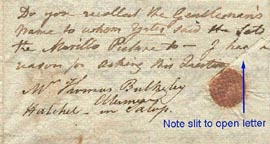This letter is written on very fine/thin parchment type of paper — unfortunately the writer was very frugal with his paper and tore the page in half so the watermark is incomplete. It was written to J Lacosta Esqre 3 Sun Court, Cornhill. This Court is still shown there on a current map in Cornhill, the heart of the financial district of London.
Postal Markings

The three postal markings trace the path it took from being handed in at the Tottenham Court Two Penny Post receiving office on Saturday 24 May 1817, to the delivery in Cornhill.
- Unpaid stamp — surprisingly that was applied in red ink which was usually confined to Paid mail, and the letter has a note (4) by the writer that it was paid ! It was transferred to the Westminster Office of the Twopenny Post, for delivery
- the datestamp — identified as being the Westminster Office, and not the Chief Office, as it has the month before day. This type of indented oval 10 o'clock Forenoon date stamp was in use until 1822.
- the handstruck '2' showing that the letter would cost twopence.
The TWOPENNY POST was a Government local post for letters posted in, or for delivery in, the London area. This was always a separate department under the Postmaster General, with separate buildings and staff. It was named the Twopenny Post only in 1805, although it had cost 2d for the letters since 1801. Letters could be handed in at Twopenny Post Receiving Offices for delivery in any part of the United Kingdom or overseas. The General Post also had Receiving Offices in London, so it all seems very complex, and only by checking the postal markings can you be sure of the details.
The Letter
Now to the letter, and for such a small item it has a lot of interest in the contents, as it covers two different subjects. The first is foreign financial dealings.
My Dear Sir,
A Friend and Relative of mine wishes to draw a Bill on Baltimore [America] & be inform'd of the manner of transacting it.1
I took the Liberty of saying you would have the Goodness to inform & direct him. I gave him your address & it is probable he may avail himself of calling Upon you some day soon — His name is W. Sutherland. He does not wish to raise money on his bill here.
I am going next week to attempt selling the Pictures which were formerly in Yates's care. On Monday they will be Up to be seen at Phillip's 73 New Bond Street. The sale comes on, on Wednesday & it w'd Gratify me your seeing them on Monday as the Auction Rooms will be then Open to View previously.
The Town is so full I thought it would not be prudent to risque keeping them till another year. I mean these Six only — as those in the Corsham House are not in a state to be seen now,
Dr Sir believe me ever with much Esteem
Yours truly
E. Grant
Saturday morning May 24.
When he had sealed the letter, he obviously had another thought, so added this sentence on the outside of the letter.
Do you recollect the Gentleman's name to whom Yates said he Sold the Murillo Picture2 to — I have a reason for asking this question.

This illustration clearly shows how neatly the letter was opened — to which there has been added a note in a different handwriting — presumably the answer.
Mr Thomas Bulkeley, Hatchel — Ellesmere in Salop3
Then on the other side of the letter there is a list of the titles of the pictures and the valuation in Guineas with a note in Spanish against the entry.
Valuation 1 Santiago Gs 500 las vala (the costs) 1 Christ } 150 no valer la mistud (no value ?) 1 the woman} 1 Philip } 1200 se duda sum originaly posseden valer bvo y Serian hein vendida 1 the Valse } 1 Isabel 150 podra valer mas este es original I cannot be sure of the Spanish here, as the writing is cramped and may well be abbreviated notes, but because it was written in Spanish, I think Senor La Costa must have visited the Phillips Galleries at 73 New Bond Street, inspected the pictures and then written his valuations on the inside of his friend's letter, so that he could reply to him later.
I have not been able to trace details of these pictures; however, I was able to find out that Phillips Galleries are still based in London and have several offices in Australia.4
It is easy to imagine that with so much of the population in 1817 being of the working class who were relatively if not totally uneducated, that life was a dull hand-to-mouth existence, but a letter like this brings home the fact that a different life was available to those with money; that financial dealings are not the sole province of the 20th century. I cannot help but wonder what happened to these six paintings, and whether the descendants of Mr Bulkeley of Ellesmere, still own the Murillo picture.
Last modified 26 May 2010